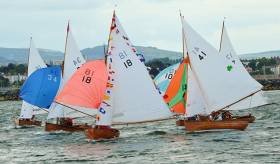Displaying items by tag: Dublin Bay Water Wag
Dublin Bay Water Wags
The historic Water Wags are the most popular senior class of two man dinghy in Dun Laoghaire or elsewhere in Ireland.
Unlike other dinghy classes in Dun Laoghaire which sail under the burgee of the Dublin Bay Sailing Club on Tuesdays and Sundays, the Water Wags sail on Wednesdays under the burgee of their own club, The Water Wag Club, which was founded in 1887.
Each Wednesday evening from April till mid-September, (weather permitting) twenty of more of these 14'-3" long open wooden dinghies compete in a race within the shelter of Dun Laoghaire harbour.
The class offers a lifestyle, with regular social events, weekends away from Dun Laoghaire in venues such as Clew Bay, Glandore, or the River Shannon.
Who competes in the Water Wag races?
There is no age limit, although most competitors are between the ages of 25 and 75.
Although many boats are sailed by husbands and wives, there are some which are steered by wives and crewed by husbands.
Newly built boats are available on about 4 months delivery, and used boats are available from the Water Wag Club
























































